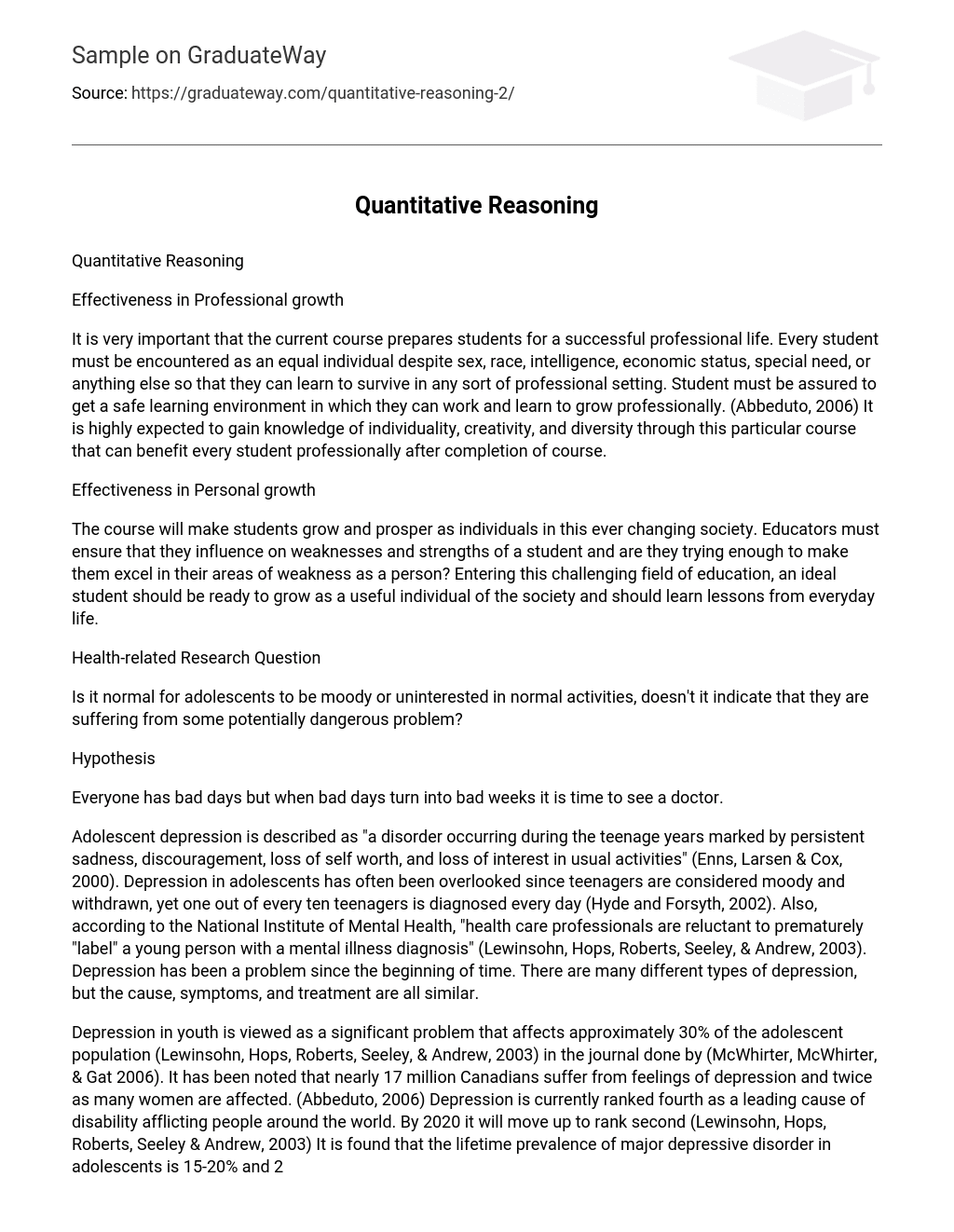Effectiveness in Professional growth
It is very important that the current course prepares students for a successful professional life. Every student must be encountered as an equal individual despite sex, race, intelligence, economic status, special need, or anything else so that they can learn to survive in any sort of professional setting. Student must be assured to get a safe learning environment in which they can work and learn to grow professionally. (Abbeduto, 2006) It is highly expected to gain knowledge of individuality, creativity, and diversity through this particular course that can benefit every student professionally after completion of course.
Effectiveness in Personal growth
The course will make students grow and prosper as individuals in this ever changing society. Educators must ensure that they influence on weaknesses and strengths of a student and are they trying enough to make them excel in their areas of weakness as a person? Entering this challenging field of education, an ideal student should be ready to grow as a useful individual of the society and should learn lessons from everyday life.
Health-related Research Question
Is it normal for adolescents to be moody or uninterested in normal activities, doesn’t it indicate that they are suffering from some potentially dangerous problem?
Hypothesis
Everyone has bad days but when bad days turn into bad weeks it is time to see a doctor.
Adolescent depression is described as “a disorder occurring during the teenage years marked by persistent sadness, discouragement, loss of self worth, and loss of interest in usual activities” (Enns, Larsen ; Cox, 2000). Depression in adolescents has often been overlooked since teenagers are considered moody and withdrawn, yet one out of every ten teenagers is diagnosed every day (Hyde and Forsyth, 2002). Also, according to the National Institute of Mental Health, “health care professionals are reluctant to prematurely “label” a young person with a mental illness diagnosis” (Lewinsohn, Hops, Roberts, Seeley, ; Andrew, 2003). Depression has been a problem since the beginning of time. There are many different types of depression, but the cause, symptoms, and treatment are all similar.
Depression in youth is viewed as a significant problem that affects approximately 30% of the adolescent population (Lewinsohn, Hops, Roberts, Seeley, ; Andrew, 2003) in the journal done by (McWhirter, McWhirter, ; Gat 2006). It has been noted that nearly 17 million Canadians suffer from feelings of depression and twice as many women are affected. (Abbeduto, 2006) Depression is currently ranked fourth as a leading cause of disability afflicting people around the world. By 2020 it will move up to rank second (Lewinsohn, Hops, Roberts, Seeley ; Andrew, 2003) It is found that the lifetime prevalence of major depressive disorder in adolescents is 15-20% and 2% during childhood, and found that 7-9% of children would experience an episode of major depression before the age 14 and as many as 20% before leaving school. In the World it has been found that roughly up to 2.5% of children and up to 8.3% of adolescents suffer from depression. (Hyde, 2002)
People need to realize that when adolescents are being moody or uninterested in normal activities, it doesn’t necessarily mean that they are being “normal teenagers.” (Abbeduto, 2006) It could indicate a potentially dangerous problem. These traits should be carefully monitored and when a pattern develops, action should be taken right away. Never wait until the last minute to make a small decision that could make a huge impact.
References
Abbeduto, L. (2006). Taking Sides: Clashing Views in Educational Psychology. McGraw-Hill Contemporary Learning Series. P. 131
Enns, M. W., Larsen, D. K., & Cox, B. J. (2000). Discrepancies between self and observer ratings of depression: The relationship to demographic, clinical and personality variables. Journal of Affective Disorders, 60, p. 33-41.
Hyde, Margaret, and Elizabeth, F. (2002) Depression-What you need to know. Franklin Watts. Canada.
Lewinsohn, P. M., Hops, H., Roberts, R. E., Seeley, J. R., & Andrew, J. A. ( 2003 ). “Adolescent psychopathology: Vol. 1. Prevalence and incidence of depression and other DSM-III-R disorders in high-school students”. Journal of Abnormal Psychology, 102, pp. 133-144.
McWhirter, B. T., McWhirter, J. J., & Gat, I. (2006). Depression in childhood and adolescence: Working to prevent despair. In D. Capuzzi & D. Gross (Eds.), Youth At Risk: A Prevention Resource for Counsellors, Teachers, & Parents (2nd Ed.) (pp. 105-128). Alexandria, VA: ACA.





